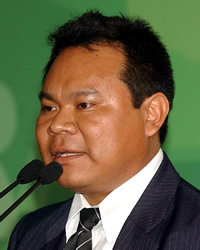Akawaio in Venezuela

Photo Source:
Elza Fiúza - Wikimedia
Creative Commons
|
Send Joshua Project a map of this people group.
|
| People Name: | Akawaio |
| Country: | Venezuela |
| 10/40 Window: | No |
| Population: | 1,100 |
| World Population: | 8,200 |
| Primary Language: | Akawaio |
| Primary Religion: | Christianity |
| Christian Adherents: | 75.00 % |
| Evangelicals: | 10.00 % |
| Scripture: | New Testament |
| Ministry Resources: | Yes |
| Jesus Film: | No |
| Audio Recordings: | Yes |
| People Cluster: | South American Indigenous |
| Affinity Bloc: | Latin-Caribbean Americans |
| Progress Level: |
|
Introduction / History
The Akawaio people primarily speak Akawaio, a Cariban language closely related to Patamona and Macushi, across Guyana, Venezuela, and Brazil, where it serves as a vital marker of cultural identity despite pressures from dominant languages like English and Spanish. Dialects of the language show significant variation, particularly between Akawaio and Patamona speakers, necessitating separate literacy materials to preserve distinct vocabularies and oral traditions. Historically, the Akawaio, known to themselves as Kapon meaning "people of the sky," have inhabited the Pakaraima Mountains and upper Mazaruni River basin along the Guyana-Venezuela border for millennia, serving as prominent traders who exchanged goods like quivers and forest products across vast networks that extended to the coastal lowlands before European arrival. European contact in the sixteenth century displaced them inland as coastal lands were seized for plantations, leading to roles as guides, hunters, and laborers under Spanish and British colonial regimes, while mid-eighteenth-century Capuchin missions in Venezuela briefly settled groups before their dispersal in 1817. By the twentieth century, Anglican, Wesleyan, and Seventh-Day Adventist missions introduced Christianity, culminating in the 1946 establishment of the Upper Mazaruni Reserve, which integrated air access and government oversight but eroded traditional autonomy amid ongoing border disputes and resource exploitation.
What Are Their Lives Like?
The Akawaio sustain themselves through slash-and-burn agriculture in the fertile Pakaraima highlands, cultivating staples like bananas, yams, taro, and cotton while practicing sustainable hunting of deer, peccaries, and tapirs with traditional blowpipes, bows, or modern firearms to supplement their diet. Gender roles shape daily tasks, with women specializing in weaving hammocks, pottery, beading aprons, and household maintenance, while men construct thatched-roof homes, boats, and hunting gear, often venturing into freelance gold mining that provides cash but disrupts family structures. Villages cluster along rivers in extended family hamlets, fostering kinship-based cooperation for fishing, gathering, and trade, though many now live in dispersed settlements due to economic migration and environmental changes. Artisanal crafts such as intricate basketry, wood carving, and music through dances like the 'Riverside Angels' troupe preserve cultural vibrancy, intertwining with communal storytelling that passes down knowledge of the landscape. Social harmony relies on bilateral kinship ties guiding marriages and conflict resolution, where disputes lead to temporary dispersal rather than confrontation, though modern challenges like mining-induced alcoholism and food shortages strain these bonds.
What Are Their Beliefs?
The Akawaio traditionally embrace a polytheistic and animistic worldview, revering a pantheon of deities including the creator Makunaima, who formed the first humans, alongside figures like Kanaima the avenger, Iwarrika the flood-bringer, and Sigu the protector, all woven into myths explaining natural phenomena and moral order. Shamans, or piye, serve as intermediaries, using hallucinogenic herbs and rituals to navigate the spirit world, heal illnesses attributed to supernatural imbalances, and ensure harmony between humans, animals, and the landscape where every rock, plant, and river holds a vital essence. Ceremonies mark life cycles with dances, songs, and offerings to appease spirits, reflecting a cosmology that views the mountains as sacred abodes of ancestral powers.
Since colonial encounters, Christianity has blended syncretically with these beliefs, giving rise to movements such as the Hallelujah Church in the mid-twentieth century, where Anglican and Adventist influences reframed traditional shamanism as prophetic visions of moral renewal and communal salvation. Today, most Akawaio profess Christian adherence, yet retain animistic practices in daily life, such as respectful hunting rites, under the guidance of church leaders who lecture on ethics drawn from both biblical and indigenous sources.
What Are Their Needs?
Secure legal titles to ancestral territories remain essential amid mining encroachments that fracture intergenerational knowledge transmission and cultural continuity. Accessible healthcare services are vital to counter tropical diseases and mining-related injuries prevalent in remote highland communities. Enhanced educational programs incorporating bilingual literacy would empower youth to navigate economic shifts while safeguarding linguistic heritage against assimilation.
Prayer Points
Pray for Akawaio hearts to encounter the transformative power of Jesus Christ, dissolving barriers between traditional animism and biblical truth for authentic faith journeys. Intercede for the emergence of indigenous pastors fluent in Akawaio, equipped to proclaim the gospel through culturally resonant stories and rituals.
Beseech God for the swift completion and distribution of full Scripture translations in Akawaio, igniting personal devotion and communal worship rooted in their native tongue.